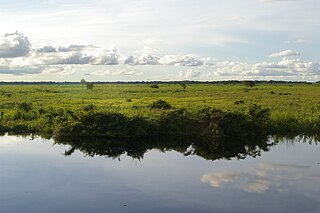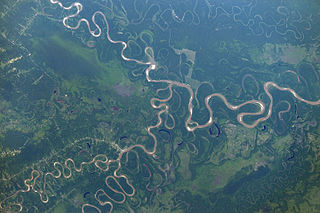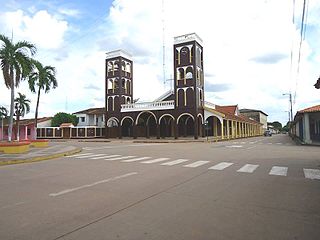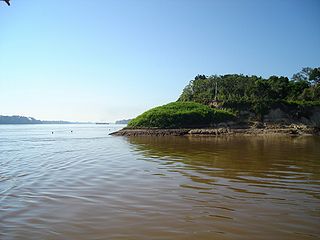
Beni, sometimes El Beni, is a northeastern department of Bolivia, in the lowlands region of the country. It is the second-largest department in the country, covering 213,564 square kilometers, and it was created by supreme decree on November 18, 1842, during the administration of General José Ballivián. Its capital is Trinidad.

Pando is a department in Northern Bolivia, with an area of 63,827 square kilometres (24,644 sq mi), in the Amazon Rainforest, adjoining the border with Brazil and Perú. Pando has a population of 154,355. Its capital is the city of Cobija.

The Mamoré is a large river in Brazil and Bolivia which unites with the Madre de Dios River to form the Madeira, one of the largest tributaries of the Amazon. It rises on the northern slope of the Sierra de Cochabamba, east of the city of Cochabamba, and is known as the Chimoré down to its junction with the Chapare. Its larger tributaries are the Chapare, Secure, Apere, and Yacuma from the west, and the Ichilo, Guapay, Ivari, Manique and Guapore from the east. Taking into account its length only, the Guapay should be considered the upper part of the Mamore; but it is shallow and obstructed, and carries a much smaller volume of water. The Guapore also rivals the Mamore in length and volume, having its source in the Parecis plateau, Mato Grosso, Brazil, a few miles from streams flowing north-ward to the Tapajos and Amazon, and southward to the Paraguay and Paraná rivers. The Mamore is interrupted by rapids a few miles above its junction with the Beni, but a railway 300 km long has been undertaken from below the rapids of the Madeira. Above the rapids the river is navigable to Chimore, at the foot of the sierra, and most of its tributaries are navigable for long distances. In 1874, Franz Keller gave the outflow of the Mamoré at mean water level, and not including the Guapore, as 41,459 cm3/sec, and the area of its drainage basin, also not including the Guapore, as 24,299 km2.

The Beni River is a river in the north of Bolivia.

Riberalta is a town in the Beni Department in northern Bolivia, situated where the Madre de Dios River joins the Beni River. Riberalta is on the south bank of the Beni River.

Guayaramerín is a city within the Bolivian Beni Department. It is the capital of the Guayaramerín Municipality in the Vaca Díez Province. Guayaramerín is located on the west side of the Mamoré River, facing the Brazilian city of Guajará-Mirim. It is a port in which there is a permanent port of the Bolivian Navy. Guayaramerín Airport is south of the city, and served by Ecojet.

Nicolás Suárez Callaú set up a multinational rubber empire in South America at the beginning of the 20th century.
Rápulo River also Ráputo River is a river in Beni Department, Bolivia. It is a tributary of the Yacuma River in the Amazon Basin. It joins the Yacuma just below the town of Santa Ana del Yacuma.

The Amazon rubber cycle, or boom was an important part of the economic and social history of Brazil and Amazonian regions of neighboring countries, being related to the extraction and commercialization of rubber. Centered in the Amazon Basin, the boom resulted in a large expansion of European colonization in the area, attracting immigrant workers, generating wealth, causing cultural and social transformations, and wreaking havoc upon indigenous societies. It encouraged the growth of cities such as Manaus and Belém, capitals within the respective Brazilian states of Amazonas and Pará, among many other cities throughout the region like Itacoatiara, Rio Branco, Eirunepé, Marabá, Cruzeiro do Sul and Altamira; as well as the expansion of Iquitos in Peru, Cobija in Bolivia and Leticia in Colombia. The first rubber boom occurred largely between 1879 and 1912. There was heightened rubber production and associated activities again from 1942 to 1945 during the Second World War.

Santa Ana del Yacuma is a town in the Beni Department in north-eastern Bolivia.

Federico Román is one of the five provinces of the Bolivian department of Pando and is situated in the department's northeastern parts. Its name honours General Federico Román.

Nicolás Suárez is one of the five provinces of the Bolivian Pando department and is situated in the department's northwestern parts. Its name honors Nicolás Suárez Callaú (1861-1940) who owned major parts of today's Pando and Beni Departments in the times of the caoutchouc-boom.
Trinidad Municipality is located in Beni Department in Bolivia.

Roberto Suárez Gómez, also known as the King of Cocaine, was a Bolivian drug lord and trafficker who played a major role in the expansion of cocaine trafficking in Bolivia. In his prime, Suárez made $400 million annually, was one of the major suppliers of the Medellín Cartel as well as the leader of the largest Bolivian drug empire, and was considered to be the biggest cocaine producer in the world.

Carlos Fermín Fitzcarrald López was a Peruvian rubber baron. He was born in San Luis, Ancash.

The Orthon River is a river in the Pando Department of Bolivia and a tributary of river Beni. The river is named after explorer James Orton, who travelled the tributary around the 1870s. A territorial claim for Antonio de Vaca Diez was carved into a tree during a later expedition by Edwin Heath. Vaca Díez was an entrepreneur in the rubber industry who would later dominate the trade on the Orthon river. Like other rubber barons, Antonio used the exploited local indigenous population as his workforce. Díez became a business partner of Carlos Fermín Fitzcarrald sometime in the early 1890s. On February 1, 1897 The Orton Rubber Co. Ltd. was registered in London by Vaca Díez. After the death of Antonio and Fitzcarrald in a river accident on the Urubamba in July 1897: rubber baron Nícolas Suárez absorbed the territory into his estate.

The Tahuamanu River is a river of Bolivia and Peru. Nícolas Suárez Callau enslaved and exploited natives along the Tahuamanu during the rubber boom.
Porvenir is a small town in the Nicolás Suárez Province of the Pando Department in Bolivia. It is located 33 kilometers south of Cobija, the department's capital city, at an altitude of 222 m on the left banks of Tahuamanu River, which in its later course is named Orthon River before it discharges into Beni River.

The Acre War, known in Brazil as Acrean Revolution and in Spanish as Guerra del Acre was a border conflict between Bolivia and the First Brazilian Republic over the Acre Region, which was rich in rubber and gold deposits. The conflict had two phases between 1899 and 1903 and ended with an Acrean victory and the subsequent Treaty of Petrópolis, which ceded Acre to Brazil. The outcome also affected territories disputed with Peru.
The Aquicuana Municipal Reserve is a protected natural reserve located about 20 km from the city of Riberalta in the Beni department in northern Bolivia and in the Amazon. It is home to Lake San José, a medicinal retreat center, Pistahua, and two communities, San José and Warnes. Its name, Aquicuana, comes from the ancestral name of the lake which was before named Aquicuana in the Tacana language and means the place of big trees.
















